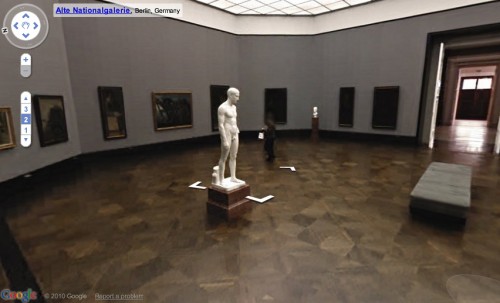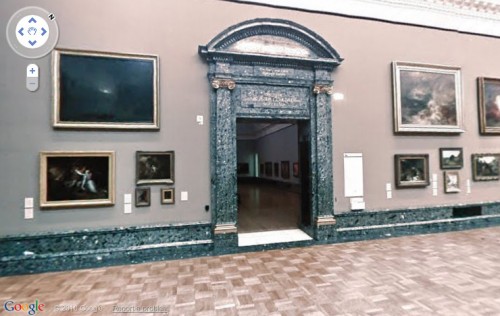Yesterday, Google launched Art Project. Art Project brings the technology of Google Maps Street View into a handful of the world’s best art museums. Users can virtually wander through various galleries and click and drag to explore full panoramic views. The experience moves beyond the street version, however, in that it lets you click to see hi-res details of selected works and allows users to save and share collections of the their favorite finds.
Most art and technology news outlets heralded Art Project as a great step forward in bringing museums and technology together, and it is. But as I started clicking around various virtual museums I found myself dwelling on the limits of the experience, despite the fact that it does so much to expand access to these museums. Running up against virtual barriers eventually became more intriguing than the art itself.
I started my journey in the Art and the Sublime gallery in Tate Britain. I’ve never been to the real Tate Britain, and I was pleased to find a truly fantastic collection of paintings there. As I meandered from piece to piece, I came to a doorway through which I could see another gallery containing paintings too distant to make out. I clicked to move through the doorway and I was awkwardly shunted to the side. Trying again, I was shifted to the other side of doorway, still unable to pass through. Checking the floor plan in a window to the right, I realized that only a limited number of galleries in the Tate were photographed for the project. As much as I loved the Sublime gallery, I found myself instead transfixed by the doorway through which I could look but not pass.
Technology often creates this effect. The closer a virtual experience gets to a genuine experience, its deficiencies become more apparent, not less. The field of robotics has encountered a similar phenomenon, dubbed the uncanny valley. The theory states that when robots and other human facsimiles look almost human, they are considerably more revolting than robots that don’t try to look human. For example, compare R2-D2 from Star Wars with any number of recent life-like androids produced in Japan. The former is endearing, while the latter is just creepy.
Later, while exploring MoMA, I found myself ignoring Rousseau’s The Sleeping Gypsy and instead pondering a painting next to it that had been blurred out. For some reason, I would guess copyright, a number of works are digitally blurred in the same way faces and license plates are blurred on Google Street View. This is disrupting to say the least. Imagine yourself standing in front of The Sleeping Gypsy in real life, and noticing that the painting next to it was covered by a shroud. Wouldn’t you want to peek?
Google’s corporate mission is as simple as it is vast: “Organize the world‘s information and make it universally accessible and useful.” The impassable doorways and blurred paintings of Art Project are significant because they represent the failure of this mission. Or at least its current limit. Even Google–a corporation whose reputation for providing access to information is so ubiquitous that its name has become a verb meaning to access information–has limits.
To be clear, I do not think the limitations of Art Project make it a failure. It’s a wonderful service. But it would be naive to think that Art Project is simply a tool that provides access to art. Google, along with every other website, is not a neutral entity. It has a purpose and it succeeds and fails in various ways. The Internet is like an artwork in that it’s much more than a simple information delivery system. The same way that Rousseau was doing much more that just showing you a gypsy sleeping by a lion, Google’s Art Project is a collection of decisions based on a particular set of assumptions, produced in a particular cultural context. When you use the Internet to give people greater access to images of paintings, it ends up being about a lot more than just painting. The delivery system is just as loaded with meaning as the content.








Pingback: Google’s Art Project and the Uncanny Museum | NCAD Library – Visual Resources
Pingback: Tweets that mention Google’s Art Project and the Uncanny Museum | Art21 Blog -- Topsy.com
Pingback: Art Project, powered by Google | antorra's weblog
Pingback: Visit museums from your computer! « Refining Your Art Practice